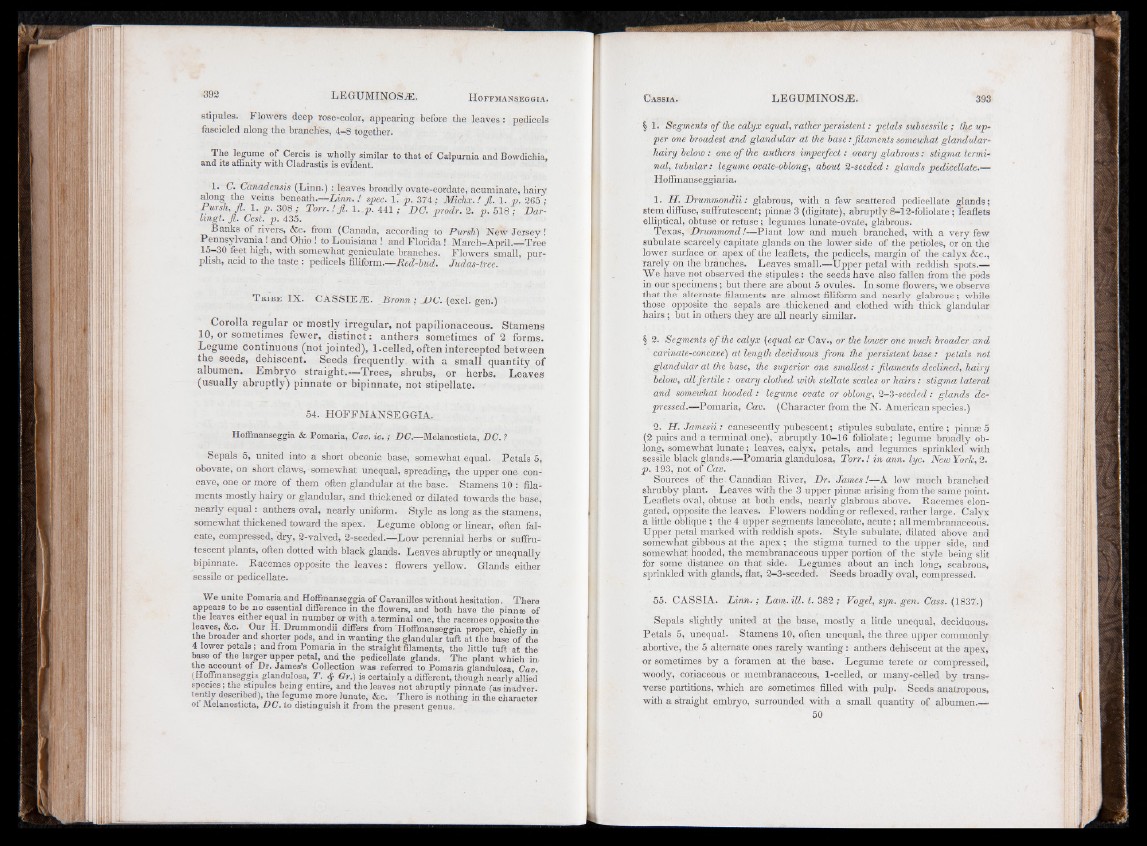
stipules. Flowers deep rose-color, appearing before the leaves: pedicels
fascicled along the branches, 4-8 together.
The legume of Cercis is wholly similar to that of Calpurnia and Bowdiehia,
and its affinity with Cladrastis is evident.
1. C. Canadensis (Linn.): leaves broadly ovate-cordate, acuminate, hairy
along the veins beneath.—Linn. ! spec. 1. p. 374; Michx.! ft. 1. p. 265 ;
Pursh, fl. 1. p. 308 ; Torr. ! fl. l..p . 441 j DO. prodr. 2. p. 5187 Dar-
lingt. fl. Cest. p. 435.
Banks of rivers, &c. from (Canada, according to Pursh) New Jersey!
Pennsylvania! and Ohio ! to Louisiana ! and Florida! March-April.__Tree
15-30 feet high, with somewhat geniculate branches. Flowers small, purplish,
acid to the taste : pedicels filiform— Red-bud. Judas-tree.
T ribe IX. GASSIER. Bronn ; DC. (excl. gen.)
Corolla regular or mostly irregular, not papilionaceous. Stamens
10, or sometimes fewer, distinct: anthers sometimes o f 2 forms.
Legume continuous (not jointed), 1-celled, often intercepted between
the seeds, dehiscent. Seeds frequently, with a small quantity o f
albumen. Embryo straight.—Trees, shrubs, or herbs. Leaves
(usually abruptly) pinnate or bipinnate, not stipellate.
54. HOFFMANSEGGIA.
Hoffmanseggia Sc Pomaria, Cav. ic. ; DC.—Melanosticta, DC. ?
Sepals 5, united into a short obconic base, somewhat equal. Petals 5,
obovate, on short claws, somewhat unequal, spreading, the upper one concave,
one or more of them often glandular at the base. Stamens 10 : filaments
mostly hairy or glandular, and thickened or dilated towards the base,
nearly equal: anthers oval, nearly uniform. Style as long as the stamens,
somewhat thickened toward the apex. Legume oblong or linear, often falcate,
compressed, dry, 2-vaIved, 2-seeded.—Low perennial herbs or suflru-
tescent plants, often dotted with black glands. Leaves abruptly or unequally
bipinnate. Racemes opposite the leaves: flowers yellow. Glands either
sessile or pedicellate.
We unite Pomaria and Hoffmanseggia of Cavanilles without hesitation. There
appears to be no essential difference in the flowers, and both have the pinnæ of
the leaves either equal in number or with a terminal one, the racemes opposite the
leaves, &c. Our H. Hrummondii differs from "Hoffmanseggia proper, chiefly in
the broader and shorter pods, and in wanting the glandular tuft at the base of the
4 lower petals ; and from Pomaria in the straight filaments, the little tuft at the
base of the larger tipper petal, and the pedicellate glands. The plant which in
the account of Dr. James’s Collection was referred to Pomaria glandulosa, Cav.
( Hoffmanseggia glandulosa, T . .)• Gr.) is certainly a different, though nearly allied
species; the stipules being entire, and the leaves not abruptly pinnate (as inadver.
tently described), the legume more lunate, &c. There is nothing in the character
of Melanosticta, DC. to distinguish it from the present genus.
S É S S É
LEGUMINOSÆ.
§ 1. Segments of the calyx equal, rather persistent: petals suhsessile ; the upper
one broadest and glandular at the base: filaments somewhat glandular-
hairy below : one of the anthers imperfect: ovary glabrous: stigma terminal,
tubular: legume ovate-oblong, about 2-seeded: glands pedicellate.—
Hoffmanseggiaria.
1. H. Drummondii: glabrous, with a few scattered pedicellate glands;
stem diffuse, suffrutescent; pinnae 3 (digitate), abruptly 8-12-foliolate ; leaflets
elliptical, obtuse or retuse; legumes lunate-ovate, glabrous.
Texas, Drummond!—Plant low and much branched, with a very few
subulate scarcely capitate glands on the lower side of the petioles, or on the
lower surface or- apex of the leaflets, the pedicels, margin of the calyx &c.,
rarely on the branches. Leaves small.—Upper petal with reddish spots.—
We have not observed the stipules: the seeds have also fallen from the pods
in our specimens; but there are about 5 ovules. In some flowers, we observe
that the alternate filaments are almost filiform and nearly glabrous ; while
those opposite the sepals are thickened and clothed with thick glandular
hairs; but in others they are all nearly similar.
§ 2. Segments of the calyx (equal ex Cav., or the tower one much broader, and
carinate-concave) at length deciduous from the persistent base: petals not
glandular at the base, the superior one smallest: filaments declined, hairy
below, all fertile : ovary clothed with stellate scales or hairs: stigma lateral
and somewhat hooded: legume ovate or oblong, 2-3 -seeded: glands depressed.—
Pomaria, Cav. (Character from the N. American species.)
2. II- Jamesii: canescently pubescent; stipules subulate, entire ; pinnae 5
(2 pairs and a terminal one), abruptly 10-16 foliolate; legume broadly ob-
Igng, somewhat lunate; leaves, calyx, petals, and legumes sprinkled with
sessile black glands.—Pomaria glandulosa, Torr.! in ann. lyc. New York, 2.
p. 193, not of Cav.
Sources of the. Canadian River, Dr. James!—A low much branched
shrubby plant. Leaves with the 3 upper pinnae arising from the same point.
Leaflets oval, obtuse at both ends, nearly glabrous above. Racemes elongated,
opposite the leaves. Flowers nodding or reflexed, rather large. Calyx
a little oblique ; the 4 upper segments lanceolate, acute; all membranaceous.
Upper petal marked with reddish spots. Style subulate, dilated above and
somewhat gibbous at the apex; the stigma turned to the upper side, and
somewhat hooded, the membranaceous upper portion of the style being slit
for some distance on that side. Legumes about an inch long, scabrous,
sprinkled with glands, flat, 2-3-seeded. Seeds broadly oval, compressed.
55. CASSIA. Linn.; Lam. ill. t. 382; Vogel, syn. gen. Cass. (1837.)
Sepals slightly united at the base, mostly a little unequal, deciduous.
Petals 5, unequal. Stamens 10, often unequal, the three upper commonly
abortive, the 5 alternate ones rarely wanting : anthers dehiscent at the apex,
or sometimes by a foramen at the base. Legume terete or compressed,
woody, coriaceous or membranaceous, 1-celled, or many-celled by transverse
partitions, which are sometimes filled with pulp. Seeds anatropous,
with a straight embryo, surrounded with a small quantity of albumen.—